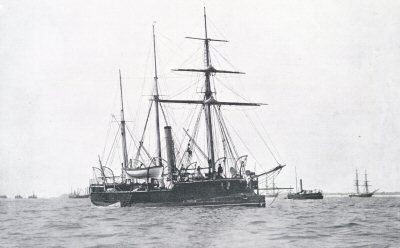Preceded by Ant-class gunboat Built 1876 - 1877 | ||
 | ||
Name Medina-class iron screw gunboat Builders | ||
The Medina-class gunboat was a class of 12 Royal Navy Rendel (or "flat-iron") gunboats mounting three 6.3-inch guns, built between 1876 and 1877. Flat-iron gunboats were normally built without masts or rigging, but the Medinas carried a full barquentine rig. Their robust iron hulls meant that they lingered on as diving tenders, barges and lighters, with five of them working into the 1920s. The hull of Medway lies in shallow water in Bermuda and is visible on satellite imagery.
Contents
Design
The Medina class were a development of the Rendel (or "flat-iron") gunboat, a series of small vessels with low freeboards which mounted a small number of relatively large guns. Although the Medinas were exceptionally provided with masts to extend their range and independence, in essence they were available for similar operations to their un-masted sisters; offensive action against shore defences. Their ungainly appearance led them to be described by the naval historian Antony Preston as "the most grotesque craft ever seen". All 12 vessels of the class were built at Palmers Shipbuilding and Iron Company in Jarrow and were named after rivers. They were constructed entirely of iron and were fitted with an unusual bow rudder.
Armament
As built, ships of the class mounted three 6.3-inch (160-mm) 64-pdr 64-cwt muzzle-loading rifles. By 1892 Trent had been fitted with a pair of 4.7-inch quick-firing guns.
Propulsion
All the ships of the class were fitted with a pair of R and W Hawthorn 2-cylinder horizontal single-expansion steam engines of 60 nominal horsepower. They developed 310 indicated horsepower (230 kW), giving a speed of about 9 1⁄2 kn (17.6 km/h).
Sail plan
All ships of the class were built with three masts and a barquentine rig of sails. Surviving members of the class had their sailing rig replaced by a pair of pole masts in the 1890s.
Operational lives
Some of the ships of the class were appointed as tenders to battleships as soon as they were built: Medina tender to Duke of Wellington and Medway to Excellent, the gunnery school at Portsmouth. Spey was fitted in 1900 with three 4.7-inch guns for service at the gunnery school.
Dee and Don served in the Mediterranean in 1886 as part of an International squadron dominated by the Royal Navy. They both remained at Malta in various capacities for the rest of their lives. Tay had her armament reduced to a single 9-pounder gun and by 1914 was a tender to HMS Vivid, the Royal Navy barracks at Devonport. Esk and Tweed both served in Hong Kong in the 1890s, being sold there in the 1900s.
In all cases the crews were not expected to live onboard their cramped ships when not at sea, with living space provided in accommodation hulks or the battleships to which the gunboats were tenders.
